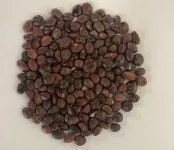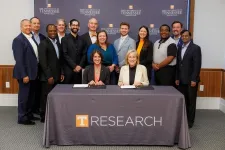(Press-News.org) The CRISPR molecular scissors have the potential to revolutionize the treatment of genetic diseases. This is because they can be used to correct specific defective sections of the genome. Unfortunately, however, there is a catch: under certain conditions, the repair can lead to new genetic defects – as in the case of chronic granulomatous disease. This was reported by a team of basic researchers and physicians from the clinical research program ImmuGene at the University of Zurich (UZH).
Chronic granulomatous disease is a rare hereditary disease that affects about one in 120,000 people. The disease impairs the immune system, making patients susceptible to serious and even life-threatening infections. It is caused by the absence of two letters, called bases, in the DNA sequence of the NCF1 gene. This error results in the inability to produce an enzyme complex that plays an important role in the immune defense against bacteria and molds.
The CRISPR tool works…
The research team has now succeeded in using the CRISPR system to insert the missing letters in the right place. They performed the experiments in cell cultures of immune cells that had the same genetic defect as people with chronic granulomatous disease. “This is a promising result for the use of CRISPR technology to correct the mutation underlying this disease,” says team leader Janine Reichenbach, professor of somatic gene therapy at the University Children’s Hospital Zurich and the Institute for Regenerative Medicine at UZH.
… but unfortunately, it’s not perfect
Interestingly however, some of the repaired cells now showed new defects. Entire sections of the chromosome where the repair had taken place were missing. The reason for this is the special genetic constellation of the NCF1 gene: it is present three times on the same chromosome, once as an active gene and twice in the form of pseudogenes. These have the same sequence as the defective NCF1 and are not normally used to form the enzyme complex.
CRISPR’s molecular scissors cannot distinguish between the different versions of the gene and therefore occasionally cut the DNA strand at multiple locations on the chromosome – at the active NCF1 gene as well as at the pseudogenes. When the sections are subsequently rejoined, entire gene segments may be misaligned or missing. The medical consequences are unpredictable and, in the worst case, contribute to the development of leukemia. “This calls for caution when using CRISPR technology in a clinical setting,” says Reichenbach.
Safer method sought
To minimize the risk, the team tested a number of alternative approaches, including modified versions of CRISPR components. They also looked at using protective elements that reduce the likelihood of the genetic scissors cutting the chromosome at multiple sites simultaneously. Unfortunately, none of these measures were able to completely prevent the unwanted side effects.
“This study highlights both the promising and challenging aspects of CRISPR-based therapies,” says co-author Martin Jinek, a professor at the UZH Department of Biochemistry. He says the study provides valuable insights for the development of gene-editing therapies for chronic granulomatous disease and other inherited disorders. “However, further technological advances are needed to make the method safer and more effective in the future.”
END
Use of “genetic scissors” carries risks
Genome editing
2024-11-06
ELSE PRESS RELEASES FROM THIS DATE:
Does work-related stress compromise cardiovascular health?
2024-11-06
In a large multi-ethnic group of adults in the United States without cardiovascular disease, those with work-related stress were more likely to have unfavorable measures of cardiovascular health. The findings are published in the Journal of the American Heart Association.
For the analysis, investigators assessed data collected between 2000 and 2002 for 3,579 community-based men and women aged 45–84 years enrolled in the Multi-Ethnic Study of Atherosclerosis. Cardiovascular health was determined based on seven metrics—smoking, physical activity, body mass index, diet, total cholesterol, blood pressure, and blood glucose—with each metric contributing zero points, ...
New research may lead to potatoes that are less reliant on nitrogen fertilizers
2024-11-06
Because nitrogen fertilizers contribute to global greenhouse gas emissions, scientists are looking for ways to modify agricultural plants so that they rely on less nitrogen. In research published in New Phytologist, investigators have found that blocking a particular protein may achieve this goal in potatoes.
The protein, called Solanum tuberosum CYCLING DOF FACTOR 1 (StCDF1), binds to DNA and plays a key role in regulating tuberization in potatoes. In this latest research, investigators found that StCDF1 ...
Do commercial ties influence ESG ratings?
2024-11-06
An analysis published in the Journal of Accounting Research uncovers evidence that conflicts of interest arising from commercial ties lead to bias in environmental, social, and governance (ESG) ratings.
Investigators focused on Moody’s and S&P’s acquisitions of ESG rating agencies Vigeo Eiris and RobecoSAM. Their analysis revealed that after these ESG rating agencies were acquired by Moody’s and S&P, they issued higher ratings to existing paying clients of Moody’s and S&P. Specifically, ...
Study assesses "gendered space" in financial institutions in Pakistan
2024-11-06
In Islamic cultures, purdah, which literally means “curtain,” is a practice that involves the seclusion of women from public observation and the enforcement of high standards of female modesty. Research published in the Journal of Management Studies examines the significance of purdah (spatial modesty) in gender relations in financial institutions in Pakistan.
The research was based on the lived experiences of women and men working in two banks based in Pakistan. One of the study’s co-authors, Shafaq Chaudhry, PhD, of the University of Central Lancashire, in the UK, sought internships for six weeks ...
Chinese herbal medicine’s potential in preventing dementia
2024-11-06
Attempts to discover a breakthrough dementia drug might be drawing attention these days, but traditional medicinal products can offer hints for preventive medicine.
A research group led by Specially Appointed Professor Takami Tomiyama of Osaka Metropolitan University’s Graduate School of Medicine has found that administering the dried seeds of a type of jujube called Ziziphus jujuba Miller var. spinosa, used as a medicinal herb in traditional Chinese medicine, holds promise in restoring cognitive and motor function in model mice.
By administering hot water extracts of Zizyphi spinosi semen to model mice with ...
Firms that read more perform better
2024-11-06
[Vienna, November 6, 2024] — “Tell me how you read and I’ll tell you who you are.” By analyzing online reading behavior across millions of firms worldwide, a new study out of the Complexity Science Hub (CSH) connects how much information companies consume and how the consumption relates to their size.
"The way companies consume information is reminiscent of biological organisms. They take in, transmit, and transform information to make decisions. As with organisms, there are important size differences. Larger firms tend to consume information more efficiently ...
Tightly tied waist cord of saree underskirt may pose cancer risk, warn doctors
2024-11-06
A tightly tied waist cord of the underskirt (petticoat) traditionally worn under a saree, particularly in rural parts of India, may lead to what has been dubbed ‘petticoat cancer,’ warn doctors in the journal BMJ Case Reports after treating two women with this type of malignancy.
The continued pressure and friction on the skin can cause chronic inflammation, leading to ulceration, and, in some cases, progression to skin cancer, say the authors.
This phenomenon has previously been described as “saree cancer,” but it is the tightness of the waist cord that’s to blame, ...
10% of children in high-burden tuberculosis settings may develop the disease by age 10
2024-11-06
EMBARGOED UNTIL 6:30 PM EST Tuesday, November 5, 2024
Contact:
Jillian McKoy, jpmckoy@bu.edu
Michael Saunders, msaunder@bu.edu
##
10% of Children in High-Burden Tuberculosis Settings May Develop the Disease by Age 10
New findings also indicate that children who live in settings with a high burden of TB have a consistently high annual risk of developing TB infection throughout childhood.
An estimated 1.2 million children develop tuberculosis disease (TB) and 200,000 kids die from TB worldwide each year, but the risk of developing TB infection and disease throughout childhood remains under-studied. Furthermore, the majority of studies on the pediatric burden of TB are informed by data ...
Health experts push for the elimination of a ‘remarkably harmful toxin’
2024-11-06
The Biden administration’s recently announced plan to replace all lead pipes in the U.S. is a reminder that the toxic metal remains a threat, even in a country that has largely banned its use. The smallest levels of lead exposure can cause a range of health damages over time, especially to children’s brain development. Stanford researchers Stephen Luby and Jenna Forsyth have spent years examining the widespread presence of lead in low-income countries, including in some commonly consumed products. They led a perspective published Nov. 5 in The Lancet Public Health that tallies lead’s global ...
University of Tennessee, Lockheed Martin expand Master Research Agreement
2024-11-05
The University of Tennessee, Knoxville, and defense technology company Lockheed Martin announced the signing of a new five-year master research agreement Oct. 31, reinforcing a longstanding partnership that helps UT take its research capabilities from the lab to the field.
“This partnership allows UT researchers to conduct true translational research,” said James Andes, director of national security research initiatives for UT. “Our research concepts are matured by working with technical champions at Lockheed Martin, and as a ...
LAST 30 PRESS RELEASES:
Decoupling the HOR enhancement on PtRu: Dynamically matching interfacial water to reaction coordinates
Sulfur isn’t poisonous when it synergistically acts with phosphine in olefins hydroformylation
URI researchers uncover molecular mechanisms behind speciation in corals
Chitin based carbon aerogel offers a cleaner way to store thermal energy
Tracing hidden sources of nitrate pollution in rapidly changing rural urban landscapes
Viruses on plastic pollution may quietly accelerate the spread of antibiotic resistance
Three UH Rainbow Babies & Children’s faculty elected to prestigious American Pediatric Society
Tunnel resilience models unveiled to aid post-earthquake recovery
Satellite communication systems: the future of 5G/6G connectivity
Space computing power networks: a new frontier for satellite technologies
Experiments advance potential of protein that makes hydrogen sulfide as a therapeutic target for Alzheimer’s disease
Examining private equity’s role in fertility care
Current Molecular Pharmacology achieves a landmark: real-time CiteScore advances to 7.2
Skeletal muscle epigenetic clocks developed using postmortem tissue from an Asian population
Estimating unemployment rates with social media data
Climate policies can backfire by eroding “green” values, study finds
Too much screen time too soon? A*STAR study links infant screen exposure to brain changes and teen anxiety
Global psychiatry mourns Professor Dan Stein, visionary who transformed mental health science across Africa and beyond
KIST develops eco-friendly palladium recovery technology to safeguard resource security
Statins significantly reduce mortality risk for adults with diabetes, regardless of cardiovascular risk
Brain immune cells may drive more damage in females than males with Alzheimer’s
Evidence-based recommendations empower clinicians to manage epilepsy in pregnancy
Fungus turns bark beetles’ defenses against them
There are new antivirals being tested for herpesviruses. Scientists now know how they work
CDI scientist, colleagues author review of global burden of fungus Candida auris
How does stroke influence speech comprehension?
B cells transiently unlock their plasticity, risking lymphoma development
Advanced AI dodel predicts spoken language outcomes in deaf children after cochlear implants
Multimodal imaging-based cerebral blood flow prediction model development in simulated microgravity
Accelerated streaming subgraph matching framework is faster, more robust, and scalable
[Press-News.org] Use of “genetic scissors” carries risksGenome editing

